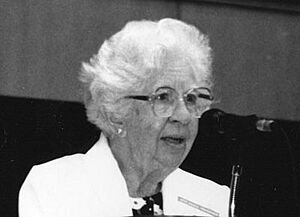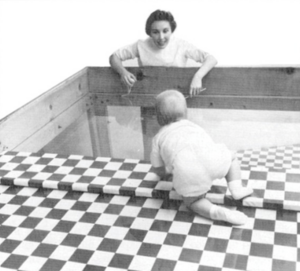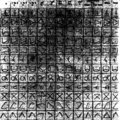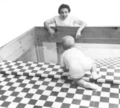Eleanor J. Gibson facts for kids
Quick facts for kids
Eleanor J. Gibson
|
|
|---|---|

Eleanor Gibson - Keynote Address - 1993 APS Convention
|
|
| Born |
Eleanor Jack
December 7, 1910 |
| Died | December 30, 2002 (aged 92) |
| Citizenship | American |
| Alma mater | Smith College (B.A., 1931) (M.S., 1933) Yale University (Ph.D., 1938) |
| Known for | Visual cliff, perceptual learning, differentiation theory, enrichment of embedded structures |
| Spouse(s) | James J. Gibson |
| Children | James J. Gibson Junior Jean Gibson |
| Awards | National Medal of Science (1992) APA Award for Distinguished Scientific Contributions to Psychology (1968) The American Psychological Foundation Gold Medal Award for Life Achievement in Science (1986) |
| Scientific career | |
| Fields | Psychology, developmental psychology, comparative psychology, experimental psychology, ecological psychology |
| Doctoral advisor | Clark L. Hull |
Eleanor Jack Gibson (born December 7, 1910 – died December 30, 2002) was an American psychologist. She studied how babies learn to see and understand the world. She also researched how people learn to read.
Eleanor Gibson started her work at Smith College in 1932. She published her first research while still a student. She overcame challenges like the Great Depression and unfair treatment because she was a woman. She found ways to do research that she loved.
With her husband, James J. Gibson, Eleanor created a theory called the Gibsonian ecological theory of development. This theory explains that seeing and understanding (perception) is super important. It helps humans adapt to their surroundings.
One of her most famous ideas was the "visual cliff" experiment. This study looked at how babies and animals understand depth perception. It helped us learn a lot about how our senses develop. Eleanor Gibson received many honors for her work. She was elected to important science groups. In 1992, she won the National Medal of Science.
Contents
Eleanor Gibson's Early Life and Family
Eleanor Jack was born in Peoria, Illinois, on December 7, 1910. Her father, William Alexander Jack, was a businessman. Her mother, Isabel Grier Jack, stayed at home. Eleanor had one younger sister, Emily.
Eleanor's Family Life
Eleanor met her husband, James J. Gibson, at Smith College. He was a professor there. They got married in September 1932. They had two children: James J. Gibson, Junior, born in 1940, and Jean Gibson, born in 1943. Eleanor took some time off from research to focus on her children and teaching.
Eleanor's Education Journey
Eleanor started college at Smith College when she was 16. She first wanted to study languages. But she soon became interested in experimental psychology. She earned her bachelor's degree in 1931 and her master's degree in 1933 from Smith.
In 1935, Eleanor began her Ph.D. at Yale University. There, she became interested in comparative psychology, which studies how different animals think and behave. She faced challenges at Yale because some professors did not want women in their labs. However, Clark L. Hull, a psychologist, became her advisor. Eleanor finished her Ph.D. in 1938.
Eleanor Gibson's Career in Psychology
Eleanor Gibson started teaching at Smith College in 1932. She took a break to get her Ph.D. at Yale. Then she returned to Smith. In 1940, she became an assistant professor.
During World War II, her husband, James, worked on perception research for the United States Air Force. The family moved to Texas and then California. After the war, they moved back to Massachusetts. Eleanor returned to Smith College in 1946.
In 1949, James Gibson got a job at Cornell University. The family moved to Ithaca, New York. Eleanor could not get a job at Cornell at first. This was because of rules that stopped spouses from working in the same department. So, Eleanor worked as an unpaid research assistant.
She continued her research by working with other professors at Cornell. She worked with Howard Liddell in his lab, which had baby animals. This made her more interested in how things develop. The idea for the Visual Cliff experiment came from her work there.
Later, Eleanor received money from the U.S. Air Force and Navy for her research. She studied how people learn to perceive things. She also worked with Richard Walk on experiments with rats. This led to the famous Visual Cliff experiment.
In 1966, the rules changed, and Eleanor became a professor at Cornell. She got her own lab in 1972. She focused on how babies perceive the world. Her lab became an infant perception lab.
Eleanor retired from her teaching job in 1979. But she kept working in her lab until 1987. She also visited other universities.
Challenges Eleanor Faced
Eleanor Gibson lived through the Great Depression. This was a time when money was scarce. She also faced gender discrimination. This meant she was treated unfairly because she was a woman.
Smith College, where she studied, encouraged women to be scholars. But Yale University, where she got her Ph.D., was different. They did not offer her financial help. One professor even refused to let her work in his lab because she was a woman. But Eleanor found other ways to reach her goals.
Her career was also affected by World War II. She moved with her husband as he did research for the military. When they moved to Cornell, she faced unfair rules again. She worked for 16 years without pay because of the anti-nepotism rule. Despite these challenges, Eleanor kept doing important research.
Eleanor Gibson's Contributions to Psychology
Eleanor Gibson made big contributions to how we understand learning and perception.
Understanding Perceptual Learning
Eleanor Gibson was greatly influenced by her husband's work. Together, they developed the Gibsonian ecological theory of development. This theory shaped her research on perceptual learning.
Eleanor believed we needed a new way to think about how we learn to perceive. She studied how children understand their environment. She and her husband thought that learning means getting better at noticing details in your surroundings. They called this process differentiation.
Imagine you are trying different wines for the first time. Many might taste similar. But someone who tastes wine often can tell them apart. This is like perceptual learning. At first, we might group similar things together. But with practice, we learn to notice the small differences.
Eleanor and James studied this using "nonsense scribbles." They showed different groups of people (kids and adults) a target scribble. Then, they showed them many similar scribbles. The goal was to find the ones that were exactly the same as the target.
At first, it was hard to tell the scribbles apart. But after trying many times, people got better at it. They learned to see the unique features of each scribble. This showed that our perception becomes more sensitive over time. We learn to notice specific details.
Eleanor also studied how we learn to read. She looked at how we perceive words and spelling patterns. She found that some letter combinations are easier to say than others. For example, "glurck" is easier to pronounce than "ckurgl." This is because "gl" often starts words in English, and "ck" often ends them. Learning these patterns helps us read faster.
What is Differentiation Theory?
Eleanor Gibson's differentiation theory is a key part of her work on perceptual learning. It says that as we experience the world, we learn to tell things apart. We do this by noticing their unique features.
In one study, Eleanor looked at how young children (ages 4 to 8) learned to tell apart "letter-like forms." These were shapes that looked a bit like letters. She showed them a standard shape and then many slightly changed versions. Some changes were small alterations to the lines. Others were changes in how the shape was turned or viewed.
Children had to say which changed shapes were still the same as the standard. Older children did much better at this task. They made fewer mistakes. This showed that as kids get older, they learn to spot the important differences. This skill is very important for learning to identify letters and read.
The Famous Visual Cliff Experiment
The idea for the visual cliff came to Eleanor while she was studying baby goats. She noticed how a newborn goat reacted when placed on a raised object. This gave her an idea about how babies might perceive depth.
Eleanor worked with Richard Walk to create the visual cliff. It was a large glass table. One side looked shallow, like a solid floor. The other side looked deep, like a drop-off. But it was actually just a pattern far below the glass.
They tested many animals, including rats, chickens, lambs, and cats. Most animals would not cross the "cliff" side. This suggested they could see depth. For some animals, like cats, they found that depth perception needed to be learned.
Finally, they tested human babies, aged 6 to 14 months. Babies were placed on the center board. Their mothers stood on either the shallow or deep side. The mothers tried to get their babies to crawl to them.
About 90% of the babies crawled onto the shallow side. But only about 10% crawled onto the deep side. Many babies who refused to cross the deep side would cry or crawl away. This showed that most babies could tell the difference between the shallow and deep sides as soon as they could crawl. This meant they had depth perception.
Eleanor Gibson's Lasting Impact
Eleanor Gibson received many awards for her important work.
Awards and Honors
- APA Award for Distinguished Scientific Contributions to Psychology (1968)
- Elected to the National Academy of Sciences (1971)
- Elected to the National Academy of Education (1972)
- Wilbur Cross Medal from Yale University (1973)
- Elected to the American Academy of Arts and Sciences (1977)
- The American Psychological Foundation Gold Medal Award for Life Achievement in Science (1986)
- The National Medal of Science (1992)
She also received 11 honorary degrees from universities. These included Smith College and Yale University.
After she retired in 1979, Eleanor continued to be involved in research. She visited many universities around the world. Her scientific discoveries continue to help us understand perception today. Her Visual Cliff Study is still taught in psychology classes everywhere.
Remembering Eleanor Gibson
Eleanor Gibson passed away on December 30, 2002, at age 92. She was an experimental psychologist. She made huge contributions to how we understand perception, how babies develop, and how we learn to read.
In 1966, she became the first woman to hold a special professorship at Cornell University. She was named the Susan Linn Sage Professor of Psychology in 1972.
Eleanor Gibson not only impacted psychology but also the people she taught. Arlene Walker-Andrews, one of Gibson's students, called her a "gifted mentor." Eleanor always treated her students like independent scholars. She gave them full credit for their work. Arlene remembered Eleanor for her strong work ethic, determination, and dedication to helping students grow.
Eleanor Gibson's Published Books
Eleanor Gibson wrote two major books that greatly influenced the field of psychology. These books expanded our knowledge of learning.
- Principles of Perceptual Learning and Development (1969)
- The Psychology of Reading (1975, with Harry Levin)
In her later years, Eleanor focused on writing books to show how her ideas developed over time. Her book, "An Odyssey in Learning and Perception," collects her academic papers from the 1930s onwards. It covers 50 years of her work on perceptual learning and development.
Her final book, "Perceiving the Affordances: A Portrait of Two Psychologists," was published in 2002. It tells the story of her life and her husband's life as psychologists.
Images for kids






